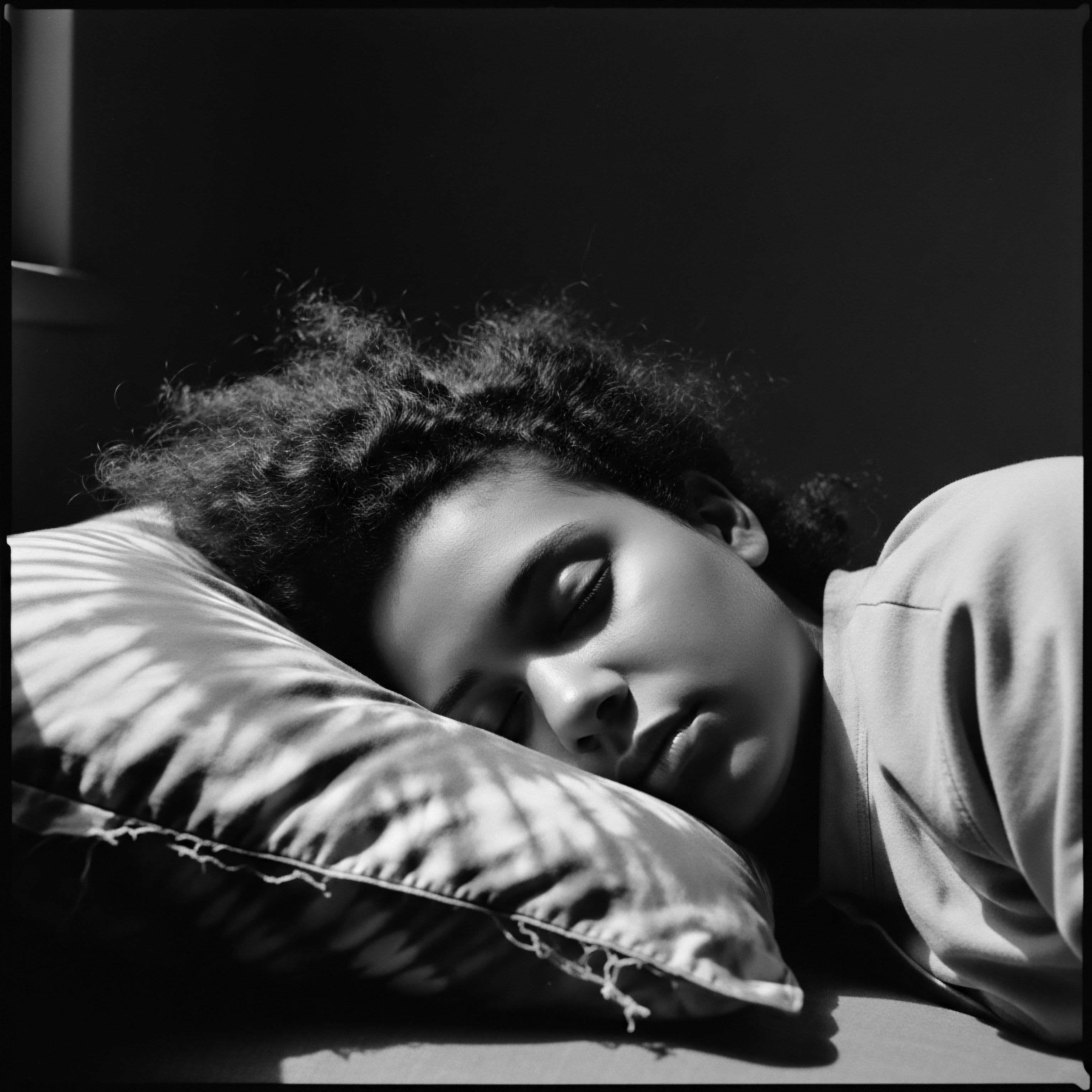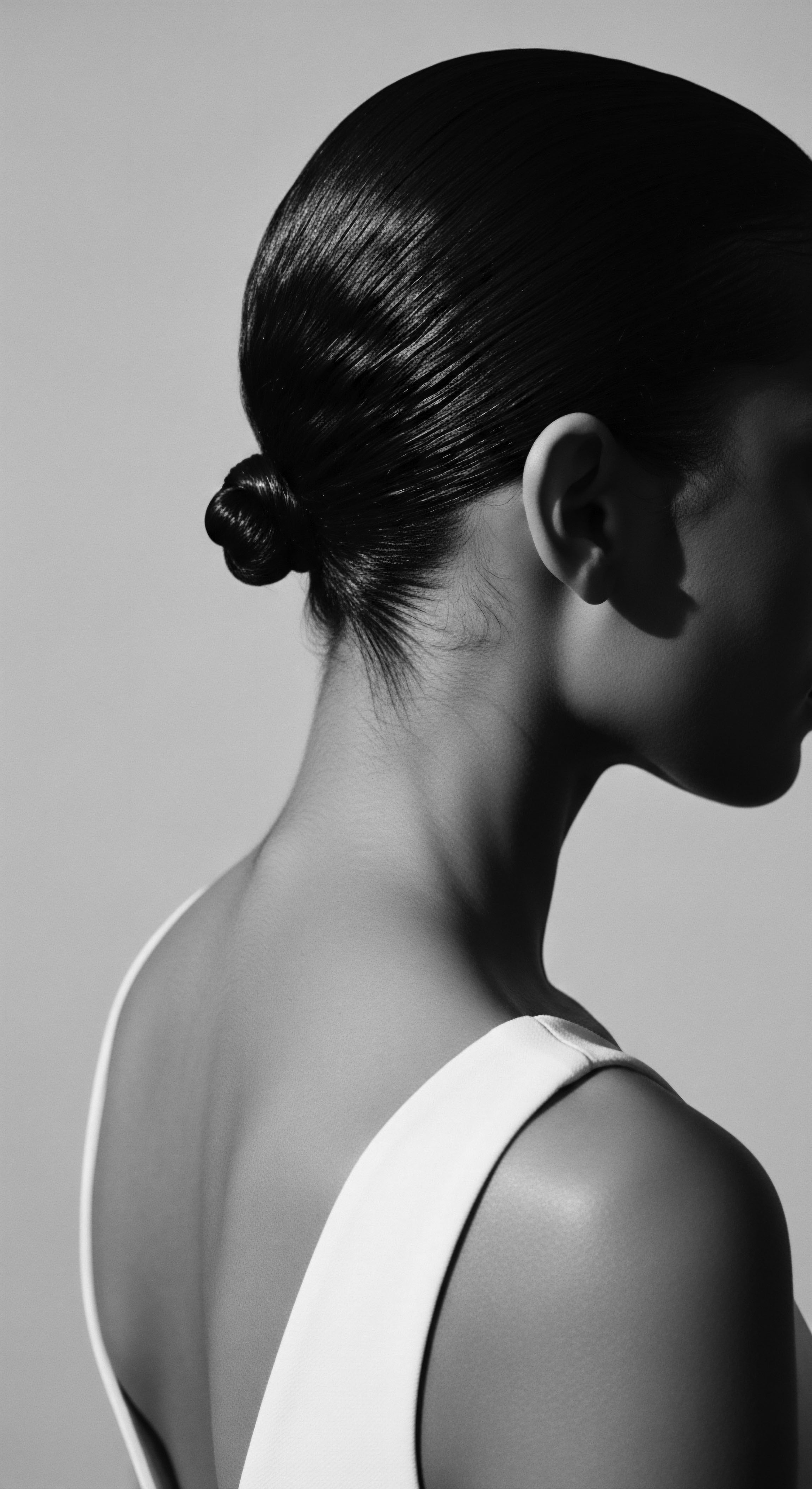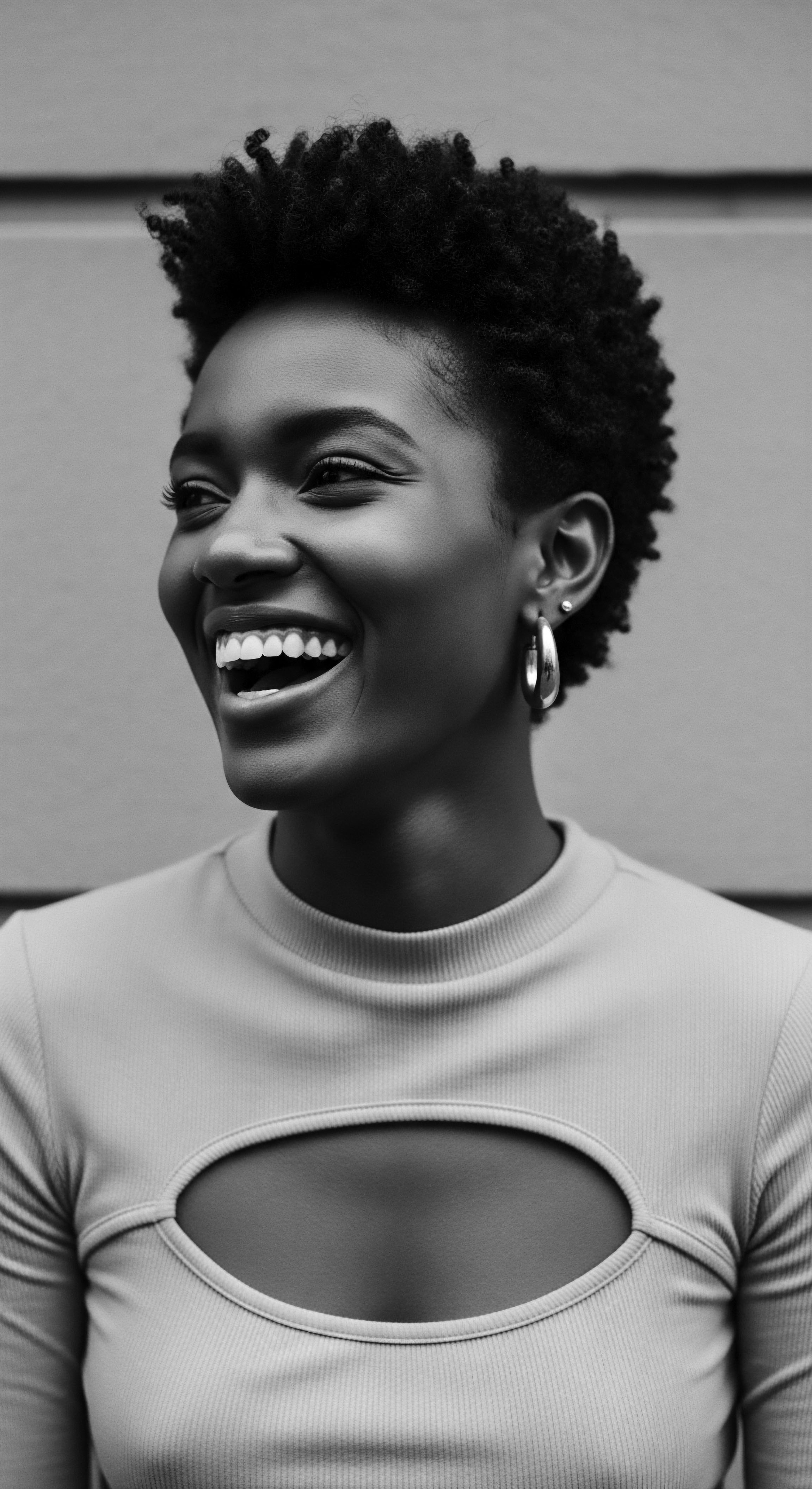
Roots
Consider the earth beneath our feet, ancient and whispering secrets of vitality. For generations uncounted, the very soil, the waters flowing from deep springs, and the rich mineral deposits held within the earth’s embrace have offered solace and strength to textured hair. This deep lineage reminds us that our relationship with cleansing is not a modern invention; rather, it is a continuum, a living echo of ancestral hands reaching for the earth’s bounty to nurture hair that speaks volumes of identity and resilience.
The coils, kinks, and waves that distinguish textured hair possess a distinct architectural design, one that has, across the ages, dictated its needs and care. Unlike straighter strands, the helical shape of textured hair creates a more complex surface area, rendering it more prone to dryness and demanding a gentle approach to cleansing. Our forebears, through centuries of observation and communal wisdom, understood this inherent thirst and approached hair care not as a task, but as a ritual of preservation. They turned to the earth, recognizing its components held the balance needed to purify without stripping, to cleanse while simultaneously conditioning.

The Earth’s Gentle Touch Mineral Components
When we speak of mineral components, we are speaking of the subtle, yet powerful, elemental building blocks that Mother Earth provides. These are the unsung heroes of ancestral cleansing, capable of absorbing impurities and gently lifting away the accumulation of daily life and previous applications. The effectiveness of these earth-derived ingredients rests upon their unique crystalline structures and their inherent negative or positive charges, which interact with the positively charged impurities on the hair shaft.
- Clays ❉ Among the most celebrated earth-derived cleansers, various clays have been used globally for centuries. Their primary mode of action is adsorption, where they draw substances to their surface, effectively pulling dirt, excess oils, and product residue from the hair and scalp. These materials are rich in minerals like silica, magnesium, calcium, and potassium, each contributing to the overall well-being of the hair and scalp.
- Saponins ❉ Found in certain plants and plant materials, saponins are natural cleansing agents that create a mild lather when mixed with water. While not minerals themselves, the efficacy of saponin-rich plants is often tied to the mineral content of the soils they grow in, which influences their phytochemical composition. Ancestral communities knew these plants intimately, using them for a delicate yet thorough cleanse.
- Mineral-Rich Waters ❉ Even the composition of water, a fundamental cleansing agent, plays a part. Waters naturally enriched with trace minerals, perhaps from ancient springs or rivers, could offer a subtle cleansing and conditioning effect, contributing to hair health through gentle mineral exchange.

An Ancestral Alchemy Clays and Their Cleansing Power
The practice of using clays for cleansing hair stretches back into antiquity, a testament to their enduring efficacy and availability. In West Africa, for instance, certain communities traditionally incorporated various earth compounds into their beauty routines, often sourcing them from specific riverbeds or geological formations. These earth elements were not merely functional; they carried symbolic weight, connecting the individual to the land and to a continuous line of practice.
Earth’s inherent mineral composition offers a gentle yet effective cleansing power, deeply rooted in ancestral hair care practices.
One such remarkable example is the use of Bentonite Clay. This volcanic ash clay, rich in minerals such as calcium, magnesium, and iron, possesses a strong negative electromagnetic charge. When hydrated, it expands, creating a porous sponge that draws out positively charged toxins, dirt, and heavy metals from the hair and scalp. Its ability to absorb impurities without stripping the hair’s natural moisture renders it particularly suited for the thirsty nature of textured strands.
Another prized earthen gift is Rhassoul Clay, also recognized as Moroccan Lava Clay. Its heritage lies in the Atlas Mountains of Morocco, where Berber women have relied upon it for centuries for both skin and hair. This clay boasts a remarkably high mineral composition, particularly magnesium, potassium, and calcium, which are thought to contribute to its unique ability to improve hair elasticity and softness. The tradition of using rhassoul speaks to a localized, sustainable practice of beauty care, passed down through matriarchal lines.
Kaolin Clay, a softer, milder clay, often appears in the gentler cleansing blends. Its light texture and less aggressive drawing power make it a kind choice for those with more delicate strands or sensitive scalps. The spectrum of these earth-derived components offers a tailored approach to cleansing, mirroring the inherent diversity within textured hair itself.
| Earth-Derived Cleanser Bentonite Clay |
| Primary Mineral Components Calcium, Magnesium, Iron, Silica |
| Earth-Derived Cleanser Rhassoul Clay |
| Primary Mineral Components Magnesium, Potassium, Calcium, Silica |
| Earth-Derived Cleanser Kaolin Clay |
| Primary Mineral Components Silica, Aluminum, Zinc, Magnesium |
| Earth-Derived Cleanser African Black Soap (Ash Content) |
| Primary Mineral Components Potassium (derived from plantain/cocoa pod ash) |
| Earth-Derived Cleanser These earth-derived materials reveal a profound connection to ancestral knowledge, offering unique mineral profiles for holistic textured hair care. |

Ritual
The transition from understanding the inherent properties of earth’s minerals to integrating them into daily hair care moves us from mere knowledge to a living, breathing ritual. For generations, the act of cleansing textured hair transcended simple hygiene; it was a ceremonial gesture, a moment of deep connection to self and community, often rooted in ancestral wisdom and the careful application of earth’s gifts. These rituals shaped not only the health of the strands but also the cultural meaning ascribed to hair.
Consider the preparations for protective styles, a cornerstone of textured hair heritage. Before intricate braids, cornrows, or twists were set, the hair and scalp needed to be meticulously prepared. Earth-derived cleansers, with their gentle yet effective action, played a crucial role in this pre-styling process. They would cleanse without stripping the natural oils essential for maintaining moisture in long-duration styles, thereby honoring the hair’s integrity.

Preserving Pattern with Earth’s Bounty
The unique curl patterns of textured hair are delicate, requiring cleansing methods that respect their structure. Many earth-derived products, particularly certain clays, offer a low-lather or no-lather cleansing experience, a distinct advantage over harsher, conventional surfactants. This gentle action helps to preserve the natural curl definition, preventing the disruption that can lead to frizz or tangling. This approach aligns perfectly with traditional hair care practices that prioritized maintaining the hair’s natural state and appearance.
Women of the Himba tribe in Namibia, for instance, have for centuries employed a unique mixture known as Otjize to cleanse, protect, and adorn their hair and skin. While primarily an aesthetic and protective application, otjize, composed of butterfat, ochre (a mineral-rich earth pigment), and aromatic resin, serves a multifaceted purpose. The ochre, a naturally occurring clay earth pigment, provides sun protection and a distinct red hue, but its mineral composition also contributes to the overall conditioning of the hair, acting as a form of earth-derived cleansing conditioner.
This practice, documented in anthropological studies, highlights how earth-derived minerals were not just for cleansing but woven into a broader cultural and protective hair ritual (Ojo, 2017). This specific historical example powerfully illuminates the connection between earth-derived products and textured hair heritage.
The choice of mineral-rich water sources for cleansing also speaks to this historical awareness. Water collected from certain springs or rivers, known to contain naturally occurring minerals, could have offered a subtle conditioning effect, contributing to the hair’s resilience and sheen. This quiet acknowledgment of the earth’s subtle gifts speaks volumes about the depth of ancestral knowledge concerning hair care.

The Community Weave Historical Cleansing Practices
Across the African continent and within diasporic communities, cleansing was often a communal activity, passed down through generations. The preparation of these earth-derived washes might have involved collective gathering of materials, grinding of clays, or infusing water with saponin-rich plants. This shared experience reinforced community bonds and ensured the continuation of ancestral wisdom concerning hair.
Traditional cleansing rituals, using earth’s abundant mineral components, were integral to maintaining textured hair’s natural form and cultural significance.
In certain West African traditions, the ash from specific burnt plants, rich in potassium, was utilized to create natural soaps. This ash, a mineral component, when combined with oils, yielded a powerful cleansing agent. This ancestral practice, though not always directly clay-based, demonstrates a sophisticated understanding of how mineral transformations could yield effective and gentle cleansing solutions for hair. The knowledge of which plants yielded the most beneficial ash and how to process it represents a heritage of botanical and mineral wisdom.
The tools used alongside these cleansers were equally significant. Simple, often hand-carved combs made from natural materials, or the careful use of fingers, ensured that the cleansing process respected the hair’s delicate coil pattern. The entire routine, from sourcing the ingredients to the final styling, represented a harmonious relationship with the natural world and an inherited understanding of textured hair’s unique needs.
| Ancestral Practice Himba Otjize Application |
| Earth Component/Principle Ochre (mineral pigment), Butterfat |
| Modern Parallel/Connection Mineral-rich pre-poos or conditioning treatments |
| Ancestral Practice West African Plant Ash Soap |
| Earth Component/Principle Potassium (ash), Plant Oils |
| Modern Parallel/Connection Potassium hydroxide in some "natural" soaps; saponin cleansers |
| Ancestral Practice Rhassoul Clay Wash |
| Earth Component/Principle Magnesium, Calcium, Potassium in clay |
| Modern Parallel/Connection Clay masks for hair; low-lather cleansers |
| Ancestral Practice The enduring wisdom of ancestral cleansing practices continues to inspire contemporary textured hair care, demonstrating a continuous heritage of natural solutions. |

Relay
The journey from ancient practices to contemporary understanding of cleansing textured hair with earth-derived products represents a relay of wisdom across generations. This intellectual passage allows us to bridge the perceived gap between ancestral knowledge and modern scientific validation, revealing how the deepest insights often reside in the simplest of elements. The components of earth, when viewed through this dual lens, gain a remarkable depth of significance, proving that efficacy and heritage often intertwine.
The scientific examination of earth’s mineral components provides compelling explanations for their traditional efficacy. Clays, for example, are phyllosilicates, meaning they possess a layered structure. This unique atomic arrangement, combined with their net negative charge, allows them to attract and adsorb positively charged ions, which often include dirt, oils, and product residues. This ion exchange capacity is a significant reason for their cleansing power, particularly on hair that can easily accumulate external environmental factors.

How Do Earth’s Minerals Interact with Hair’s Chemistry?
The interaction of mineral components with the chemistry of textured hair is quite fascinating. The slightly acidic pH of healthy hair (around 4.5-5.5) helps to keep the cuticles flat and smooth. Many clays, when mixed with water, can have a slightly alkaline pH (often between 6.5 and 7.5), which can help to gently swell the cuticle, allowing impurities to be released.
Once rinsed, the hair naturally returns to its acidic state, allowing the cuticle to lay flat again, sealing in moisture and protecting the inner cortex. This delicate dance of pH is a testament to the earth’s subtle yet profound influence on hair health.
Moreover, the specific minerals within these earth-derived products contribute directly to hair health beyond mere cleansing. Consider Magnesium, abundant in rhassoul clay. Magnesium plays a role in numerous enzymatic reactions within the body, and its presence can contribute to cellular regeneration and scalp health, indirectly supporting hair growth and strength. Silica, another pervasive mineral found in many clays and botanical extracts like horsetail, is a building block for collagen and elastin, crucial proteins for hair strength and elasticity.
A study on the use of African Black Soap (often containing potash, a potassium-rich mineral, derived from plantain skins or cocoa pods) found it effective for skin cleansing and conditions like eczema. While primarily focused on skin, the underlying principles of its cleansing action – derived from its saponin and mineral content – extend to hair, showcasing a traditional mineral-infused cleanser whose efficacy can be understood through modern chemical analysis (Adebamowo & Adeyemo, 2007). This work helps ground the ancestral use of such plant-derived mineral sources in scientific understanding.

The Revival of Cleansing Heritage
The resurgence of interest in earth-derived products for textured hair cleansing is not simply a trend; it is a profound reclamation of heritage. For generations, dominant beauty narratives often promoted products that were ill-suited for, or actively harmful to, textured hair, sometimes encouraging practices that distanced individuals from their natural hair identity. The return to clays, botanical washes, and mineral-rich ingredients marks a conscious choice to honor ancestral wisdom and to nurture hair in alignment with its intrinsic structure and needs.
Reclaiming earth-derived cleansing methods is a powerful act of heritage, connecting us to ancestral wisdom and the inherent needs of textured hair.
This movement also speaks to a desire for authenticity and transparency in products. Consumers are increasingly seeking ingredients that are traceable to their source, understandable in their composition, and gentle in their action. Earth-derived cleansers, often possessing a minimal ingredient list, fulfill this yearning for simplicity and purity, echoing the unadulterated practices of previous generations.
The understanding of how different mineral concentrations in water (hard versus soft water) can affect textured hair also plays a role in this dialogue. Hard water, rich in calcium and magnesium ions, can leave mineral deposits on hair, leading to dryness and brittleness. Certain earth-derived cleansers, particularly clays, can assist in chelating or binding to these hard water minerals, helping to prevent their buildup and preserving the hair’s natural moisture balance. This highlights how earth-derived products can address both external impurities and environmental challenges to textured hair.
This knowledge, spanning from the microscopic interactions of minerals to the sweeping cultural movements of natural hair affirmation, forms a continuous, dynamic heritage. It reminds us that the quest for healthy, vibrant textured hair is a timeless one, perpetually drawing inspiration from the earth’s ancient wisdom and the enduring spirit of our ancestors.

Reflection
As we step back from the granular exploration of earth’s mineral components and their profound impact on textured hair cleansing, we are left with a deeper appreciation for the enduring legacy woven into each strand. Our hair, beyond its physiological existence, remains a living archive, holding the echoes of ancestral resilience, ingenuity, and a profound connection to the natural world. The earth-derived cleansers, humble in their origin yet potent in their action, serve as a tangible link to this rich heritage, reminding us that the most vital lessons often reside in the simplest, most fundamental elements.
The journey of understanding what minerals cleanse textured hair is a testament to the continuous dialogue between past and present. It is a dialogue that celebrates the wisdom of those who, generations ago, understood the inherent gifts of the soil, the rhythm of nature, and the unique needs of hair that defied conventional standards. Their hands, guided by intuition and intimate knowledge of their environment, laid the groundwork for contemporary practices that seek to honor, rather than alter, the magnificent diversity of textured hair.
To choose an earth-derived cleanser is, in a way, to participate in an ancient ritual, to commune with the very origins of care. It is an acknowledgment that the beauty of textured hair is not merely external, but a reflection of a deeply rooted heritage, a story of survival, adaptation, and radiant self-acceptance. In this ongoing exploration, the earth’s mineral components offer not only physical cleansing but also a spiritual nourishment, affirming the profound truth that the soul of a strand is forever bound to the heart of the earth and the enduring spirit of its people.

References
- Adebamowo, C. A. & Adeyemo, A. A. (2007). The epidemiology of keloids ❉ a review of the literature. Journal of the American Academy of Dermatology, 57(3), 555-560.
- Ojo, S. (2017). African Hair ❉ A History of Hair Care and Styling in Africa. New York ❉ Abrams Books.
- Williams, L. J. (2020). Hair Story ❉ Untangling the Roots of Black Hair in America. New York ❉ St. Martin’s Press.
- Blyden, N. (2019). African Americans and the New Millennium ❉ A History of Hair in the African Diaspora. Washington, D.C. ❉ Howard University Press.
- Deters, A. (2008). Properties and applications of bentonite as a drug delivery carrier. Pharmaceutical Development and Technology, 13(5), 373-380.
- Carretero, M. I. & Hontoria, E. P. (2015). Clays and health ❉ an overview. Applied Clay Science, 107, 1-13.
